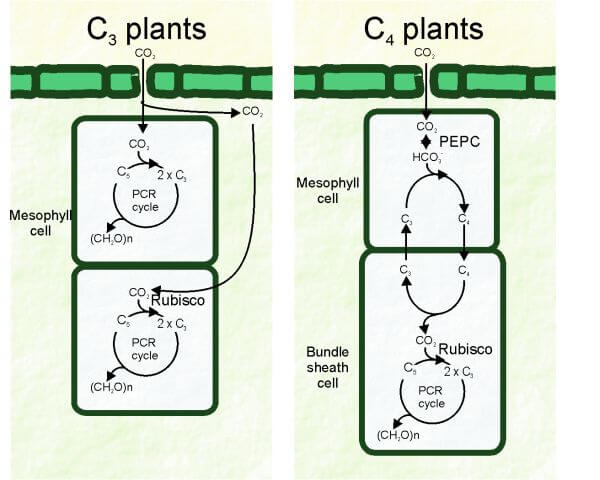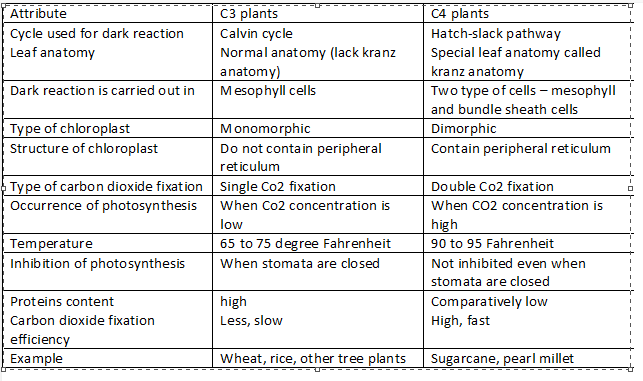Difference between C3 and C4 plantsTo run the economy of a country peacefully and smoothly, a good yield of crops is important. It helps in keeping people properly fed. There are various factors that play an important role in deciding the yield of a crop. One of the most important factors governing crop growth and yield is photorespiration. In recent studies, it was found that the single factor which reduced the soybean crop yield by 36% and wheat crop yield by 20% in the United States is photorespiration. 
Photorespiration is a metabolical energy-expensive process that gives more harm than benefit to plants. Photorespiration takes place when the main enzyme of the Calvin cycle, called Rubisco, starts utilizing oxygen in place of carbon dioxide. In the process, the fixed carbon is utilized along with the expenditure of energy. It happens when the plant's stomata are shut off to conserve water. Photorespiration happens mostly when the climate is hot (during high temperatures). There are plants that can escape this wasteful process due to the presence of specific adaptations. Based on the ability of the plant to avoid the photorespiration process, the plants are divided into three categories: C3 plants, C4 plants, and CAM plants. C4 and CAM plants possess the ability to avoid photorespiration even when the temperature is high. They have evolved plants with natural selection to allow an increase in respiration and minimize photorespiration. C3 plantsThis category includes normal plants without any special structure or adaptation. They do not have any mechanism to avoid or reduce the process of photorespiration. The process of fixing the carbon into sugars is called the Calvin cycle. The first step in the Calvin cycle is to fix the atmospheric carbon dioxide with the help of an enzyme called Rubisco. These plants are called C3 plants because the first step of the Calvin cycle results in the formation of a three-carbon compound called 3 Phosphoglyceric Acid (3-PGA). More than 85% of the plant species in the world use the C3 mechanism for carbon fixation. Some examples include soybean, wheat, trees, rice, etc. C4 plantsThe Hatch-Slack pathway, also known as C4 carbon fixation, is one of three recognized photosynthetic carbon fixation pathways in plants. The names are a result of Marshall Davidson Hatch and Charles Roger Slack's 1960 discovery that some plants integrate the 14C label into four-carbon compounds first when given 14CO2. Although most terrestrial plants fix carbon by the C3 pathway, there are some plants that use another pathway for carbon fixation. These plants are called C4 plants, and the pathway is called the C4 carbon fixation pathway. In contrast to the C3 pathway, where Rubisco was used as the primary carboxylation enzyme, C4 plants use another enzyme, phosphoenolpyruvate (PEP) carboxylase. The need for another mechanism for carbon fixation is due to the inefficiency of Rubisco in certain atmospheric conditions. RUBISCO can catalyze the process using two different substrates, carbon dioxide, and oxygen, in two different reactions. When RUBISCO uses oxygen as a substrate, the process becomes inefficient, and the product formed is harmful to the plants as it requires a lot of energy. This phenomenon which occurs when oxygen is used as a substrate, is called photorespiration. This loss is omitted in C4 plants because they follow a different mechanism of carbon fixation. In C4 plants, the CO2 is concentrated around Rubisco, which prevents oxygen from acting as a substrate, and as a result, photorespiration is prevented. There are two separate compartments in the C4 plant's leaves. The compartments are two types of cells called mesophyll cells and bundle sheath cells. This compartmentalization makes sure that RUBISCO is functioning in an atmosphere that is concentrated with CO2 and not O2. During the first stage of the process, the PEP carboxylase functions in fixing CO2 in the mesophyll cells. The reaction takes place between 3-carbon phosphoenol pyruvate (PEP) and carbon dioxide gas, which results in the four-carbon product that is oxaloacetic acid (OAA). OAA is reduced into malate and aspartate intermediates. These intermediates, later on, diffuse into the bundle sheath cells and gets decarboxylated there. This whole process ensures that bundle sheath cells are concentrated with CO2, and RUBISCO, which is present in bundle sheath cells, does not undergo photorespiration. After the reaction of RUBISCO, the product, pyruvate, again diffuses back into the mesophyll cells along with half of the phosphoglycerate (PGA). In order to complete the reductive pentose phosphate cycle, PGA is reduced chemically and again diffuses back to the bundle sheath cells. On the one hand, these extra steps demand more ATP energy to regenerate PEP. However, concentrating CO2 makes it possible for photosynthesis to occur at rapid rates, even at high temperatures. Henry's law states that a higher concentration overcomes a decreasing gas solubility with temperature. High gradients of CO2 concentration across the stomatal pores are also maintained by the CO2 concentrating mechanism. As a result, C4 plants typically have lower stomatal conductance, less water loss, and higher overall water usage efficiency. Because PEP carboxylase is produced at a far lower cost than RuBisCO, C4 plants are likewise more effective at utilizing nitrogen. However, the C3pathway is more effective in situations where photorespiration is constrained, which is often at low temperatures and in the shade. This is because it does not require extra energy for the regeneration of PEP. Difference between C3 and C4 plants
Next TopicDifference between
|
 For Videos Join Our Youtube Channel: Join Now
For Videos Join Our Youtube Channel: Join Now
Feedback
- Send your Feedback to [email protected]
Help Others, Please Share










